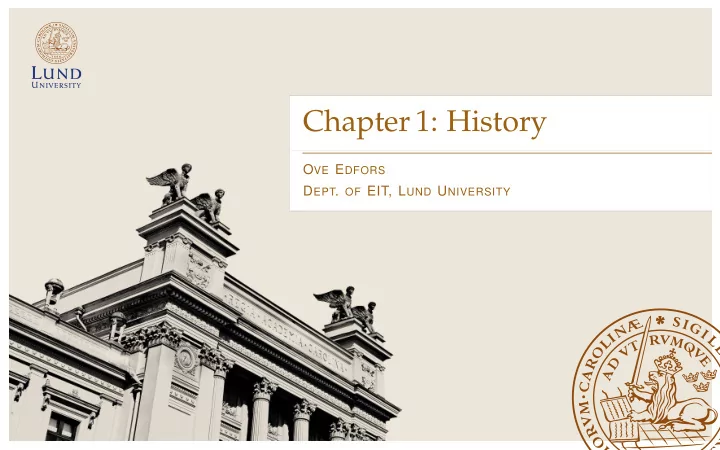

Chapter 1: History O VE E DFORS D EPT . OF EIT, L UND U NIVERSITY
Learning outcomes Understand • which important mechanisms and trends lead to telecom innovations, • why digital information systems often are preferable, • different types of information characteristics, and • what is happening (on a high level) in standardization of 5G. O. Edfors EITA30 - Chapter 1 1
Hallmarks of telecom innovations • Usually come out of several places • A full usable system must be proposed • A system must be financed • Must provide a new major service (”Killer app”) • Usually based on old science • Inventors are problem solvers , not scientists • Social effects fully felt only after 50 years • Often monopolies , force standardization O. Edfors EITA30 - Chapter 1 2
Technology trends leading to telecom • Electrical signaling (wires, radio, fiber) • Microcircuits • Software • Scientific understanding (Maxwell, Nyquist, Shannon, et al.) for (k=0;k<N,k++){ /* Do something */ } O. Edfors EITA30 - Chapter 1 3
Why going digital? • Inexpensive hardware � 1 � 2 3 years – Moore’s law: Cost = 2 – VLSI technology (also for analog circuits) • New services possible – E-banking, email, web, travel booking, distributed lifestyle • Control of quality – When there is a chain of steps → Digital better – Quality set by number of bits (bit rate) O. Edfors EITA30 - Chapter 1 4
Why going digital? • Flexible transport/switching – Same format for all – Easier, no quality loss Text Text Voice Voice Video Video • Interference rejection – A lot of interference in wireless communications, e.g., mobile telephony • Security – Much easier in the digital domain 5 O. Edfors EITA30 - Chapter 1
Characteristics of information • The communication medium – Radio (i.e., no medium), electric current, write on paper, smoke • Delay – Letters – days – Email – seconds – Live radio – milli-seconds • Quality – CD → telephone → military radio • Measures – Nr. of symbols – Meaning (of text, of emotions) – Shannon: entropy • Form – Symbols (text, programs, ...) – Analog waveforms (voice, video) – Feelings O. Edfors EITA30 - Chapter 1 6
Well known examples Telegraph Telephone Radio TV Internet Inventor/where Morse, USA, 1844 Bell, Canada/USA, Marconi, Italy/Eng- Many (extend ra- Many (DARPA) 1876 land, 1895 dio) Full system Key, code, wire Telegraph + switch- Telegraph + spark CRT, camera, high Rules, packets, PC lines ing, mic, earphone transm., receiver freq. networks How financed? Line-by-line growth Switch-by-switch None, set by None, set by None (use existing growth growth growth (govern- phone net) ment) Killer app Short business ... same (but per- ... same (but-ship- Broadcasting Email & web messages sonal) to ship) Science base None None at first, 1915: None at first, 1920: Radio & Circuits VLSI tube, 1985: fiber tube circuit ideas Inventor’s idea Magnetism “at a Switching: au- Wireless telegraph Radio with pictures Rules (TCP/IP), distance” tomation packets Social effects Wider idea of na- ... same + instant & ... same + instant & Poplulation control, ??? tion & business, friendly friendly entertainment military tactics, Monopoly? US: Western US: AT&T, SE: US: AT&T, SE: US:private, SE: Out of control (al- Union, PTT Televerket PTT Televerket PTT SR/SVT PTT most) 7 O. Edfors EITA30 - Chapter 1
Today: 5G standardization – what happens? International Telecommunication Union (ITU) has defined a timeline for 5G standardization, known as IMT-2020, but they are not the only one driving the work. • 3GPP : The 3rd Generation Partnership Project, contributes to the ITU standard, but they are not alone • 5G Infrastructure Public Private Partnership (5GPPP) : Industry academia research consortia • Next Generation Mobile Networks (NGMN) Alliance: includes wireless operators like AT&T, U.S. Cellular and Verizon, aims to include operator voices in the 5G discussion, • FCC, ARIB, ETSI ... : Telecom Standards Institues O. Edfors EITA30 - Chapter 1 8
Today: 5G standardization – what happens? O. Edfors EITA30 - Chapter 1 9
LECTURE SUMMARY • Many things have to be in place for a new innovation to succeed (full system, financed, etc.) • Trends towards digital: Electrocal signaling, microcircuits, software, . . . • Why digital? Cost, new functionality, control of quality, flexibility, security, . . . • Information: Medium, delay, quality, measure, form, . . . • Today: 5G standardization: What is happening? O. Edfors EITA30 - Chapter 1 10
Recommend
More recommend